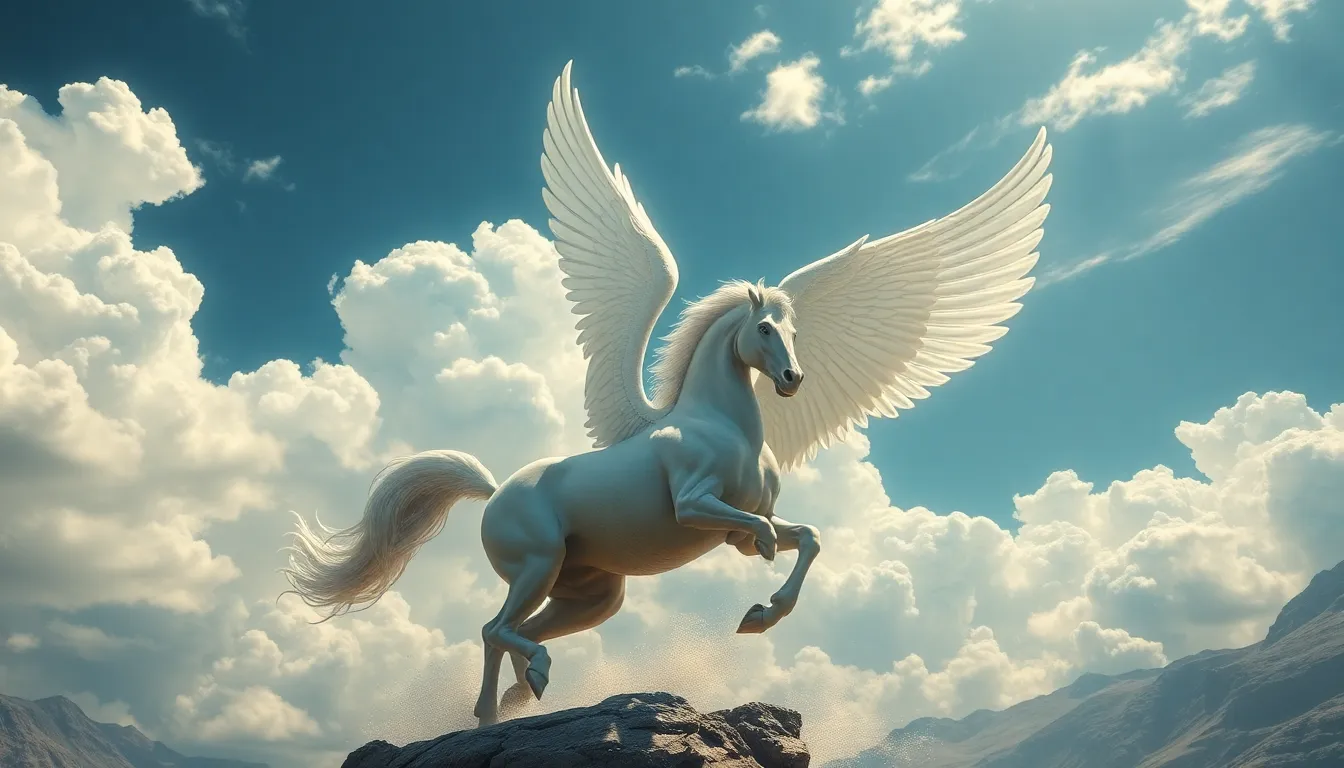The Birth of Pegasus: From Medusa to the Sky
I. Introduction
Pegasus, the magnificent winged horse of Greek mythology, has captivated the imagination of people for centuries. This extraordinary creature is not only a symbol of beauty and grace but also embodies the duality of creation and destruction in the ancient narratives. In Greek culture, Pegasus represents inspiration, creativity, and the connection between heaven and earth. To understand the birth of Pegasus, one must delve into the tragic story of Medusa, whose transformation and fate are intricately linked to the emergence of this celestial being.
II. The Myth of Medusa
Medusa, once a beautiful maiden, was one of the three Gorgon sisters, daughters of Phorcys and Ceto. Her transformation into a monster with snakes for hair was a punishment from Athena, after Poseidon violated her in Athena’s temple. This metamorphosis made Medusa a figure of terror, capable of turning anyone who gazed upon her into stone.
Medusa’s role in Greek mythology extends beyond her monstrous form; she represents the themes of fear, power, and the consequences of beauty. The Gorgons, including Medusa, symbolize the dual nature of femininity—both nurturing and destructive. Medusa’s story serves as a cautionary tale about the dangers of vanity and the harshness of divine retribution.
- Origins: Daughter of Phorcys and Ceto.
- Transformation: Cursed by Athena.
- Symbolism: Fear, power, and the duality of femininity.
III. The Birth of Pegasus
Pegasus’s birth is a dramatic event that occurs when Perseus beheads Medusa. As her blood spills onto the ground, Pegasus emerges, symbolizing the extraordinary nature of life that can arise from tragedy. This moment emphasizes the connection between beauty and monstrosity, as Pegasus, a creature of unparalleled elegance, is born from the violent act of slaying a Gorgon.
Poseidon, the god of the sea, is also integral to this myth, as he is often associated with both Medusa and Pegasus. Some variations of the myth suggest that Poseidon was involved in Medusa’s conception, further linking the themes of divine influence and the complex relationships between gods and mortals. The birth of Pegasus can be interpreted as a metaphor for duality, showcasing how beauty and monstrosity can coexist.
IV. Pegasus and Bellerophon
Pegasus’s story continues with Bellerophon, a hero who seeks to tame the winged horse. After receiving guidance from the goddess Athena, Bellerophon manages to capture Pegasus using a golden bridle. Together, they embark on a series of adventures, including the defeat of the Chimera, a monstrous fire-breathing creature.
The bond between Bellerophon and Pegasus is pivotal in Greek mythology, illustrating the themes of heroism, companionship, and the quest for glory. Pegasus serves not only as a steed but also as a symbol of Bellerophon’s aspirations and his journey towards achieving greatness.
- Key Events: Taming of Pegasus, defeating the Chimera.
- Significance: Represents the hero’s journey and aspirations.
- Relationship: A bond of mutual respect and partnership.
V. Pegasus in Ancient Art and Literature
Pegasus has been a prominent figure in ancient art, depicted in sculptures, pottery, and frescoes. Artists often illustrated him alongside various heroes, showcasing his significance in heroic narratives. Notable representations include:
- Vase paintings depicting Bellerophon and Pegasus.
- Sculptures that highlight Pegasus’s grace and power.
- Frescoes in ancient temples celebrating the divine horse.
In literature, Pegasus appears in works by classical authors such as Hesiod and Ovid. These texts explore his origins, feats, and the symbolism associated with him. Over time, the image of Pegasus has evolved, reflecting changing cultural values and artistic styles throughout Greek history.
VI. The Symbolism of Pegasus
Pegasus transcends his role as a mythical creature, emerging as a powerful symbol of inspiration and creativity. Often associated with the Muses, the goddesses of the arts, Pegasus embodies the idea that beauty and creativity can elevate the human spirit. His ability to soar through the skies represents the aspiration for artistic and intellectual achievement.
Additionally, Pegasus’s dual nature as a creature of both heaven and earth emphasizes the interconnectedness of the mundane and the divine. He serves as a reminder that inspiration can arise from even the most unexpected sources.
VII. Pegasus in Modern Culture
The legacy of Pegasus continues to thrive in contemporary culture, influencing literature, film, and art. Modern reinterpretations often explore his character in new and innovative ways, reflecting current themes and concerns. Some notable examples include:
- Films that depict Pegasus as a symbol of freedom and heroism.
- Literary works that explore his origins and adventures in contemporary settings.
- Artistic representations that blend traditional imagery with modern styles.
Pegasus’s enduring appeal lies in his ability to inspire creativity and embody the ideals of heroism and aspiration across generations.
VIII. Conclusion
The journey of Pegasus, from the blood of Medusa to the skies, encapsulates the rich tapestry of Greek mythology. His birth signifies the complex interplay of beauty and monstrosity, while his adventures alongside Bellerophon highlight themes of heroism and aspiration. As a symbol of inspiration and creativity, Pegasus continues to resonate in modern culture, reminding us of the timeless nature of these ancient stories.
Ultimately, the significance of Pegasus in Greek mythology lies in his ability to transcend time, offering valuable lessons about the dualities of life, the nature of inspiration, and the enduring power of myth.




